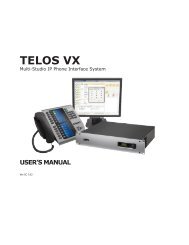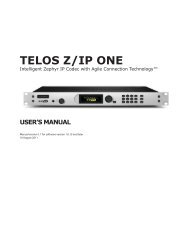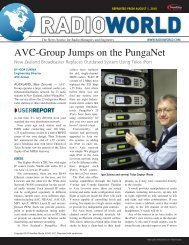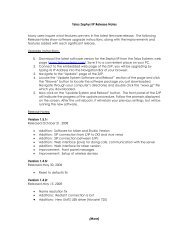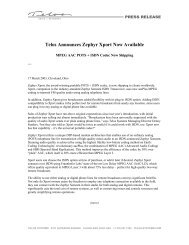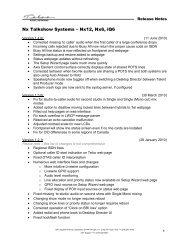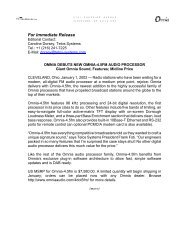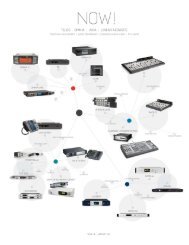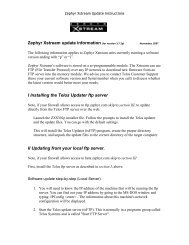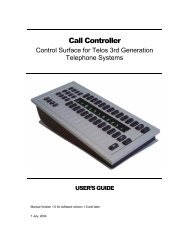Hx1-Hx2 Manual-1.4.1 - Telos
Hx1-Hx2 Manual-1.4.1 - Telos
Hx1-Hx2 Manual-1.4.1 - Telos
You also want an ePaper? Increase the reach of your titles
YUMPU automatically turns print PDFs into web optimized ePapers that Google loves.
TelepHone TerMInoloGy GuIDe | A9<br />
ILEC – Incumbent Local Exchange Carrier. A local Exchange Carrier which entered the<br />
marketplace before the enactment of the 1996 Telecom act;. i.e. a telephone company which is<br />
neither an Indi nor an RBOC. See LEC and CLEC.<br />
IMUX – See Inverse Multiplexing.<br />
In Band Signaling- A signaling system where network information such as address and routing<br />
information are handled over the communications (voice) path itself. Usually the information is<br />
represented in the form of audible tones, however DC loop current signaling also qualifies as In<br />
Band Signaling. See also CCIS.<br />
Incumbent Local Exchange Carrier. See ILEC. See also CLEC & LEC<br />
Independent – Any of the phone companies in existence at the time of divestiture that were not<br />
affiliated with the Bell System. See RBOC, LEC, and CLEC.<br />
Indi- See Independent.<br />
Interconnect Company- A vendor of telecommunications CPE other than a BOC or AT&T.<br />
This term was originated by AT&T and was meant to be derisive towards the fledgling industry<br />
when the courts said it was OK for end users to buy equipment from someone other than the<br />
Bell System. This industry flourished, in spite of AT&T’s disdain, and ironically, the RBOCs<br />
were not allowed to sell CPE under the terms of the break up of AT&T. With the current state<br />
of deregulation, the RBOCs are slowly re-entering this business. The term is now considered<br />
archaic at the time of this writing.<br />
Inter-exchange Carrier- See IEC.<br />
Interwork- The ability of two different type of networks to communicate seamlessly. For<br />
example, ISDN can interwork calls to both the POTS network and the Switched-56 network.<br />
ISDN - Integrated Services Digital Network- A relatively new and highly flexible type of<br />
telephone service which allows dialing on digital channels with multiple bi-directional “Bearer”<br />
channels each with a capacity of 56 or 64 Kbps and a single bi-directional “D channel”. See BRI<br />
and PRI.<br />
ISDN Protocol - The “language” used for communication between the Telco’s switch and the<br />
customer’s Terminal Adapter. Each ISDN circuit has one protocol, and the protocol has no<br />
effect on where or whom one may call. See ETS 300, National ISDN, and Custom ISDN.<br />
ISDN 2- A term used in Europe for ISDN BRI. Also called SØ. Not to be confused with<br />
National ISDN-2. See BRI.<br />
ISDN 30- A term used in Europe for ISDN PRI. Also called S2M. See PRI.<br />
ISG – Incoming Service Grouping. A Hunt Group. See Hunt Group.<br />
IXC- IntereXchange Carrier- See IEC.<br />
Kbps- KiloBits Per Second. Measure of digital channel capacity.<br />
Key Telephone System – A system that allows multiple telephones to share multiple predetermined<br />
telephone lines. The system provides indicators to allow the user’s to understand<br />
the status of each line available on a given phone. In its most basic form it is up to the user to<br />
provide the intelligence to select an unused line, or answer a ringing line, for example. See also<br />
PBX.<br />
LATA- Local Access and Transport Area. The area within which calls are routed by your Local<br />
Exchange Carrier (LEC). Under the divestiture of the Bell System calls going outside of this<br />
area must be handled by an Interexchange carrier (IEC). With the latest round of de-regulation<br />
the usual IEC companies are being allowed to compete in the IntraLATA long distance market



